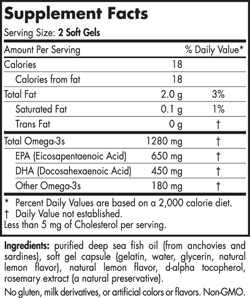Omega 3’s – Are they all created equal?
In addition to other medications, we frequently utilize a blend of omega-3s to help reduce inflammation associated with conditions like dry eye. I always tell patients that the BRAND of omega-3s are not as important as what TYPE of omega-3’s they are getting.
It is important to look at WHERE the omega-3s are coming from and not simply the TOTAL amount of omega-3s. Many patients see relief from their dry eye symptoms with between 1,000 and 2,000 mg per day of omega-3s. Just looking at the “Total omega-3” value can be misleading. When prescribing this amount, we want AT LEAST 70% of the “Total omega-3s” to come from EPA (eicosapentaenoic acid) and DPA (docosahexaenoic acid)… so of the 1,000 mg, at least 700 mg should come from the combination of EPA and DHA. If this is not the case, much of what is being taken (this is labeled as “Other omega-3s”) is not helpful.
Recently a patient brought in the bottle of the omega-3s she had been taking. She said that it was from Costco and that the “Kirkland brand always uses the highest quality ingredients”. Again, labeling can be misleading and this one was, here is the label from the Kirkland brand (click on the images to enlarge):
What is interesting about this labeling is that it states that there are 1,000 mg of “Natural Fish Oil” and that it provides 300 mg of “Total Omega-3 Fatty Acids” but does not tell you the concentration of each component. On further investigation (calling the company) you can find that of the 300 mg of “Total Omega-3”, 250 mg come from EPA or DHA. So only 25% of what she was taking was useful. At that dose she was not noticing an improvement in her symptoms. So to get the 700-1,400 mg of EPA/DHA that we want when treating this condition she would have to take 3000-6000 mg of filler fish oil, which will likely cause significant stomach upset.
Here is the labeling from 2 high quality omega-3 supplements, see if you can tell the difference:
and:

Nordic Naturals ProOmega
Both of these are high quality omega-3s and will help significantly in reducing symptoms of burning, itching, tearing, redness and irritation associated with dry eyes.
So remember, when purchasing an omega-3, pay attention to the label since they are not all created equal!
— Christopher Wolfe, OD, FAAO

